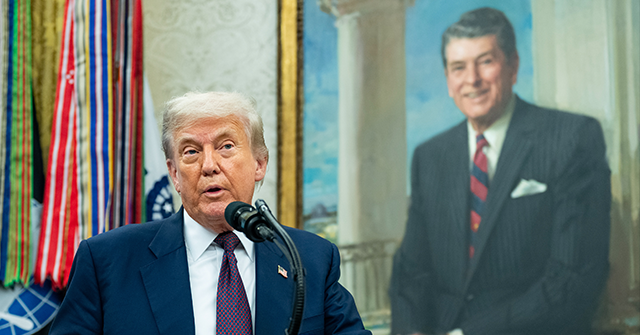When the Chips Are Down, Tariffs Beat Subsidies
President Donald Trump this week said he is planning to impose a 100 percent tariff on imported computer chips unless manufacturers are also investing in U.S. production, telling reporters that “if you are building in America, there is no charge.”
The announcement came as two economists, Ran Zhuo of the University of Michigan and Audrey Tiew of New York University, released a new working paper that may help vindicate the administration’s confidence in its tariff-first strategy. Using a detailed structural model of the global contract semiconductor market, the authors find that a modest 10 percent import tariff can shift production decisions in favor of the United States, transforming a hypothetical U.S.-based chip fabrication facility from a long-term money-loser into a more profitable investment than an identical plant in Taiwan.
By contrast, the kinds of capital subsidies and tax credits offered under President Biden’s CHIPS Act—while substantial—do not by themselves tip the balance. Even with those incentives, the U.S.-based plant ends up earning between $1.6 billion and $1.8 billion less over its projected lifetime than a comparable facility abroad, largely due to higher labor, construction, and operating costs.
The findings offer an empirical challenge to the subsidy-first approach favored by the Biden administration and suggest that market access—rather than just financial support—may be the more decisive factor in industrial location decisions. It upends the widespread assumption among economists that subsidies are superior to tariffs.
Why the U.S. Still Struggles to Compete in Chip Making
Zhuo and Tiew simulate a U.S.-based version of “Fab 14,” a real production facility operated by Taiwan Semiconductor Manufacturing Company (TSMC), the world’s largest contract chipmaker. In their model, the U.S. site faces a $1.2 billion higher capital cost than the Taiwan facility, a disadvantage only partially offset by public subsidies.
Even when the model includes a 10 percent construction grant and a 25 percent investment tax credit, the U.S. fab remains less profitable. Export restrictions, such as the U.S. ban on advanced chip sales to China, and Chinese tax holidays for domestic chipmakers further reduce profits across the board, but do not shift the underlying preference for overseas production.
A cyclist rides past the headquarters of the Taiwan Semiconductor Manufacturing Company (TSMC), a Taiwanese multinational semiconductor contract manufacturing and design company, in Hsinchu, Taiwan, on April 16, 2025. (Daniel Ceng/Anadolu via Getty Images)
In other words, the subsidy strategy alone fails to overcome the location disadvantage. In the absence of additional policy measures, the model suggests that firms will continue to favor building abroad.
When Tariffs Enter the Equation
The pivotal result in the paper comes when the authors simulate a 10 percent tariff on imported chips. That modest duty—far lower than the 100 percent tariff announced by Trump—reorients demand toward the U.S. facility, particularly as the technology matures and foreign competitors become more active in the market.
With the tariff in place, the U.S. fab is able to retain domestic customers for mature-node chips used in sectors like defense, automotive manufacturing, and industrial machinery. In this scenario, the American plant becomes more profitable by $5.9 billion over its lifetime—more than reversing the earlier deficit.
The authors do not evaluate the broader economic effects of tariffs. Their focus is narrowly on the incentives that drive where chipmakers choose to build.
Still, the result is striking: among the major levers of industrial policy, tariffs—not subsidies—appear to have the clearest power to change the investment calculus.
The Trump Tariffs Succeed While The CHIPS Act Fails
The paper adds academic weight to a broader political shift. The CHIPS Act, passed in 2022 with bipartisan support, committed more than $50 billion to reviving the U.S. semiconductor sector. Several major companies—including Intel, Samsung, and TSMC—announced plans to expand American operations, though some have since delayed or downsized those efforts amid rising costs and workforce constraints.
The Biden administration frequently insisted that these announcements were evidence that public investment can bring high-tech manufacturing home. But the slower-than-expected rollout has also raised questions about whether subsidies alone are enough to drive structural change.
Trump, on the other hand, has pursued a more aggressive industrial strategy focused on reshaping global trade flows rather than underwriting private investment. The Zhuo–Tiew paper does not directly endorse that approach, but its findings offer a quantitative rationale for Trump’s claim that tariffs are a more direct and effective tool for restoring domestic production capacity.
The paper’s central finding—that location decisions are sensitive to relatively small shifts in trade policy—suggests that a targeted use of tariffs, even at moderate levels, can influence global manufacturing patterns more quickly than subsidies, which often take years to deploy.
Whether the Trump administration’s proposed 100 percent tariff produces the same result remains to be seen. The authors did not model duties at that scale, and it is unclear how such a dramatic move would affect international supply chains or global semiconductor prices.
Still, the timing of the paper’s release, alongside the administration’s new tariff announcement, may help reframe the debate over how best to bring chipmaking back to U.S. soil. If public investment alone is insufficient to alter a company’s preferences, as the research suggests, then tariff policy—long treated as a blunt instrument—deserves the central place in U.S. economic strategy that Trump has given it.
Read the full article here


